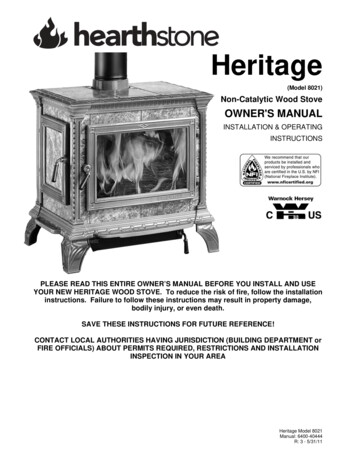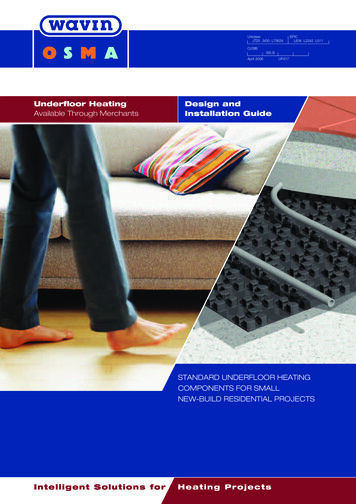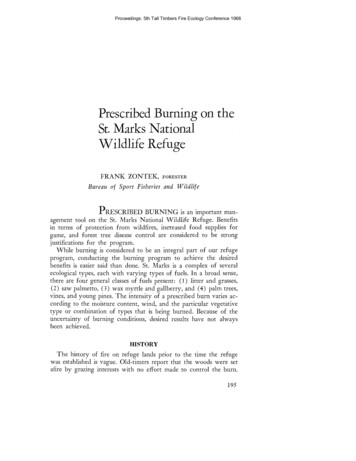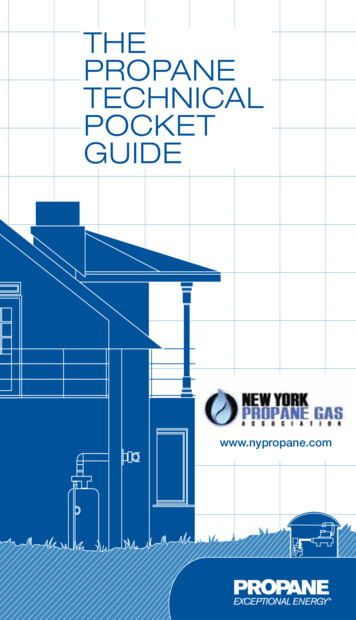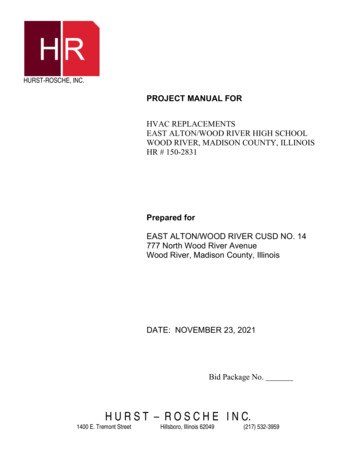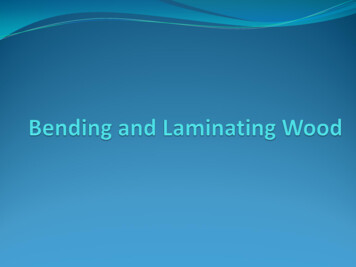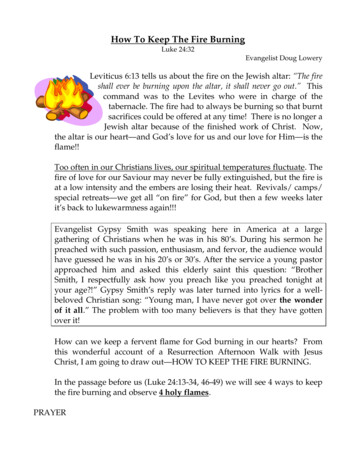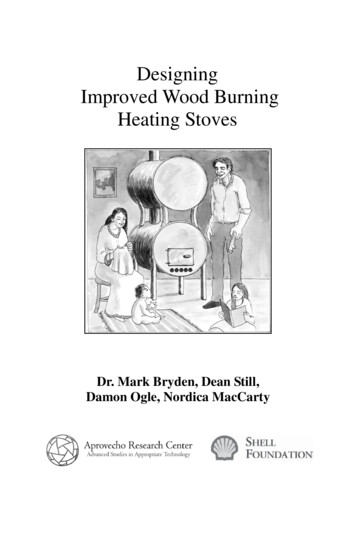
Transcription
DesigningImproved Wood BurningHeating StovesDr. Mark Bryden, Dean Still,Damon Ogle, Nordica MacCarty
To: Kim, Victor, Max, Hanna, and Dougwho keep Dean warm
Designing Improved Wood Burning Heating StovesTable of ContentsChapter 1Learning from Cooking Stoves .3Chapter 2Patterns forCombustion Chambers 10Chapter 3Heat Exchangers . 13Chapter 4Examples: Heating Stoves 26Appendix A:Options for InsulatingCombustion Chambers 52Illustrated by: Mona Cancino, Mike Ledawski, EthanHughes, Brian Thomas, Mike Van, Jayme VinyardLayout and Design: Jeremy Roth3
Designing Improved Wood Burning Heating StovesChapter 1- Learning from Cooking StovesAprovecho Research Center has been investigating how to burn woodand biomass since 1976. Most of this work has been with cooking stoves.However, a lot of the lessons that were learned experimenting withcooking stoves are applicable to heating stoves as well. After years ofinvestigation, it became clear that heat transfer to the pot largelydetermines the fuel efficiency of a cooking stove, especially since highcombustion efficiency (transforming a large part of the wood into heat) isrelatively easy to achieve.The Technical Director atAprovecho is Dr. LarryWiniarski, MechanicalEngineer. Larry is a giftedteacher who has led ourinvestigations at theresearch center. Thecooking and heating stoveswhich Aprovecho helpsindigenous groups developaround the world are hisinventions. Larry’sAn improved cook stoveunderstanding of stovethermodynamics hasresulted in a set of design principles that can be used to create manytypes of stoves.One of Dr. Winiarski’s key observations is that that the combustionchamber (where the fire burns) is only one part of the successful heatingstove. The heat exchanger assists heat transfer to the room, largelydetermining how much wood is used.The first job of an improved stove is to achieve nearly completecombustion of fuel (turning almost 100% of the wood into heat) and tonot allow smoke, which is un-combusted fuel, to escape. Enough airneeds to rush into an insulated chamber to create a hot fierce fire thatburns cleanly. The second job of the good heating stove is to get close to100% of the heat into the room.4
Designing Improved Wood Burning Heating StovesChimney Pipes are Poor Heat ExchangersA cylindrical chimney pipe allows a lot of the heat to escape instead offorcing the heat into the room where it can be of use. The chimney pipeis an inefficient heat exchanger. Hot flue gases rush up the middle of thepipe, avoiding the friction of the sides. So, a large portion of the heatcreated by burning wood is wasted as it escapes up the chimney and outinto the cold air beyond the windows and walls. Testing at Aprovechohas shown that capturing the lost heat dramatically reduces fuelconsumption. Using a good heat exchanger gets families warmer morequickly using less fuel!Clean Burning FirstA good combustion chamber changes wood or other biomass into heatwithout creating much smoke or creosote (condensed wood tars).Complete combustion of wood results in two byproducts: carbon dioxideand water vapor. In contrast, incomplete combustion creates unburnedparticles that cause pollution and creosote that fills chimneys and cancause chimney fires if it ignites.Complete combustion is the goal of the combustion chamber. But a slowburning heating stove cannot burn wood very cleanly. Nearly completecombustion in a wood burning stove can be achieved by doing thefollowing things:1.) Metering the fuel– Cutting wood up into smaller pieces and feedingthem at a proper rate into the fire as they are consumed.2.) Making a hot fire- Creating a combustion zone where fuel, flame andair are mixed by turbulence, at a high enough temperature, for a longenough time to completely combust. Combustion temperatures mustbe hot enough to assist burning all escaping gases released from thewood.Remember that wood itself does not burn. Wood gets hot andthen releases constituent gases that hopefully all burst intoflame. The remaining solid residue, char, is then combusted toform carbon dioxide. A hot fire is a clean fire. A lazy firepollutes the air which humans need to breathe.5
Designing Improved Wood Burning Heating Stoves3.) Insulating the combustionchamber– Insulation helps to keeptemperatures high.Ignition Temperature(Fahrenheit in Air) of Wood Gases4.) Igniting escaping smoke–Passing smoke, which is uncombusted fuel, through a flame.Hydrogen750ºCarbon Monoxide 1125ºMethane1000º5.) Providing sufficient oxygen–Starving the fire slows it, cools itdown, and produces smoke.Combustion Engineering, Borman &Ragland, 19986.) Warming and increasing the velocity of the cold air entering the fire–Air is warmed as it passes through a small opening into the combustionchamber. For systems without a fan, make enough small holes underthe door into the combustion chamber so the holes have as much crosssectional area as the chimney exiting the stove. Position the holes sothat primary air is sucked into the coals and up into the combustingwood. Do not allow the user to block the holes reducing primary air.Blocking the necessary amount of air will create pollution. The rate ofburn in a heating stove should be determined by the amount of fuel in thecombustion chamber, not by shutting off air to the fire.7.) Forming a grate out of the firewood– Sticks burning close togetherheat each other and keep the temperatures high. The pattern should bestick, air, stick, air, with even spaces between the sticks.8.) Creating sufficient draft– Use a tall enough chimney or better yet asmall fan. An insulated chimney creates a lot more draft than an uninsulated chimney. High velocity, low volume jets of hot air enteringunder the fire, up though the coals, create mixing which reducesemissions. Do not use a damper in the chimney. Design the stove to runefficiently with enough air entering and leaving the stove to burn fuelcleanly.Complete combustion cannot occur when starting a stove because thecombustion chamber is too cold. An insulated combustion chamber willheat up more quickly and then, when burning metered amounts ofbiomass, make less smoke. Throwing a big log on the fire, however,always makes smoke. The log cools the fire and releases more pyrolysisgasses that overwhelm the available air and are too cold to be combusted.6
Designing Improved Wood Burning Heating StovesWithout enough air, wood cannot burn cleanly. The size of the air inletsinto the fire should add up to be about as large as the chimney exiting thestove. The power level of the stove should be set by the wood loadingrate, not the air flow. When users try to control the power of the stove byshutting off air to the fire they can send horrible plumes of smoke out ofthe chimney. A stove must have enough air to function efficiently.Metering the FuelThrowing a big log on the fire is like dumping a gallon of gas down thecarburetor of a car all at once. The car may keep running, if it doesn’tstall completely. However, smoke will certainly pour out of the exhaustas the car struggles to burn too much fuel.Fuel needs to be metered to achieve efficient combustion. That’s whycars have carburetors that precisely mix just the right amount of air, fuel,and spark. The improved heating stove does the same thing, burning upthe gases and not letting them escape without combusting.7
Designing Improved Wood Burning Heating StovesPellet StovesMany pellet stoves don’t smoke because just the right amount of fuel isdelivered as it is burned up. A fan makes it possible to preheat the aircoming into the fire and assures good mixing of gases, air and flame.Lots of air is needed for hot clean burning. The amount of heat isregulated by adjusting how much fuel enters per minute into the fire. In apellet stove, fuel drops down into a small crucible, replacing the burningfuel at the same rate it is consumed. This small amount of fuel combustscompletely. Little smoke and few emissions exit out the chimney.Metering fuel makes clean burning easy. In a regular wood burningstove, the same thing can be accomplished by burning small pieces of drywood and watching to make sure that a fierce flame is present. A littleobservation teaches the operator quickly how to maintain clean burning.Unfortunately, adding fuel at regular intervals is much more demandingand time consuming than just throwing a log onto the fire and thenignoring the smoke polluting the environment.WoodCombustion chamberPellet Stove8
Designing Improved Wood Burning Heating Stoves9
Designing Improved Wood Burning Heating StovesChapter 2- Patterns forCombustion ChambersIf smoke passes through flame, it ignites. Which one of the followingpatterns has the greatest potential for clean burning?The illustrations on pages 10 & 11 show different clean-burning patternsof feeding wood into a combustion chamber.1.) The pattern that Dr. Winiarskifavors is downdraft/down feed. Thewood is burned at the bottom of avertical stick that falls down as it isconsumed. Air is pulled downalongside the sticks and into the fire.The coals fall in front of the flamepath and help to create a secondenvironment that ignites smoke. Awall of flame is pulled horizontallyinto an insulated space. Smokeescaping the initial burn will1.) Downdraft /downfeedusually ignite in the flame. Thedown feed/downdraft stove is clean burning like the pellet stove becauseof the metering of fuel into the fire.2.) Side feed/side draft is howmost people feed a fire. Thesticks are pushed into the fire asthey burn. In this pattern, thefire creates coals that lieunderneath the flame which isless helpful for assistingsecondary combustion. Withcare however, side feed can bean effective option.2.) Side feed10
Designing Improved Wood Burning Heating Stoves3.) The third pattern is to pack the wood into the combustion chamber.This is called batch loading. The sticks are vertical and hold each otherup.If you wanted to minimize smoke would you light the fire at the topor bottom of the stack?If the batch of wood is lit at thebottom any escaping combustiongasses rise up and away from theflame. Lighting the stack at thetop, on the other hand, can resultin clean burning because smoke ismore likely to pass through flame.Masonry heating stoves often usethis top burning technique.3. Top burning11
Designing Improved Wood Burning Heating Stoves4.) There is, of course, a fourth pattern for a combustion chamber. Logsof wood are in an enclosure and held up off the floor by a grate . Thelarge pieces are started burning using kindling. Air is supplied throughholes which create high velocity jets that pass up through the charcoal tothe burning wood.Do not allow theuser to block theholes reducingprimary air* or toreduce airflow in thechimney by using adamper. Cuttingdown the primary airmakes smoke,creating pollutionand wasting fuel.Using a damper createsmore smokeGiven plenty of air, theGratelogs will burn withoutLots of primary airtending for a couple ofhours, making the stove easy to use. Providing enoughprimary air and insulating around the fire will not alter the nature of thisarrangement. This is an inevitably smoky pattern. On the other hand, thispattern is so pleasant to use that even though it can be environmentallyunfriendly it has to be included as an option.*Primary air directly enters into the fire, secondary air enters above the fire to assistthe mixing of fuel air and fire and to provide oxygen if needed for combustion of gases.Secondary air must be used very carefully in stove design to ensure that is does not coolthe flame too much.12
Designing Improved Wood Burning Heating StovesChapter 3- Heat ExchangersThere are three types of heat exchangers generally used to capture theheat produced in the combustion chamber. The hot flue gases can: A.)Heat mass, like heavy stone or masonry B.) Heat water which thenwarms the house or C.) The easiest and least expensive route is to makethe hot stove gases efficiently heat the air inside the room.Heat exchangers increase heat transfer to the room by making sure thatthe hot flue gases leaving through the chimney are as cool as possible.Even a smoldering fire turns at least 70% of the wood used into heat.Heat transfer efficiency (heatdelivered to the room) can beWhen analyzing a system, try toless than 20% in poorlyimprove the least efficient partdesigned systems. As thefirst. This has the greatestcartoon shows below, a littlebeneficial effect on overallimprovement in heat transfersystem efficiency!equals impressive increases infuel efficiency.13
Designing Improved Wood Burning Heating StovesChoosing Between Air to Air andAir to Mass Heat ExchangersHigh mass heat exchangers were created in the days of drafty houseswhen heating air was a losing proposition. Old houses had air exchangerates of more than 10 exchanges per hour. All the air in the house wasreplaced ten times or more every hour! It didn’t make sense to heat airthat would quickly be outdoors.Storing heat in a large thermal mass inside the house does two things:1.) Allows big hot clean burns that store the excess heat instead of overheating the interior of the house, and 2.) even when full of stored heat,the surface of the heat exchanger remains at a relatively low temperatureso that radiant heat is released at a slower rate per hour into the livingspace. The big warm rock in the living room heats occupants by radiationeven when the room air is cold. High mass stoves are perfectly suited tothe cold drafty environments for which they were designed.Drafty Houses Constantly Lose HeatToday many houses are not so drafty. Modern houses can have one-halfan air exchange per hour. Heating air becomes an acceptable option. Thehot air has time to warm occupants and interiors. Sealing the cracks thatallow air into the house is the most important first step to holding heat ina house. Insulating the house is the second most effective step in usingA lot of peoplestill live in draftyhouses with a lotof air exchangesper hour. An airto-mass stoveevolved to heatjust such a house.It is less necessaryto use a massiveheat exchangerin tighter, betterinsulated houses.Heat the inside, not the outside14
Designing Improved Wood Burning Heating StovesPluses and Minuses:Massive Heat ExchangerPositive1. The mass stores heat that can keep the house warm overnight.2. Gentle radiant heat feels good.3. Burning time can be reduced.4. The fire can be huge and hot resulting in clean burning. Since theheat is stored at a lower temperature to be released more slowly, theroom doesn’t tend to overheat.Negative1. Stored heat is there if you need it or not. If the day suddenly getswarmer, the room can overheat.2. The mass takes up room. To store sufficient heat, the heat exchangermust weigh thousands of pounds.3. The cold mass will take a long time to heat up and warm the room.Coming home and lighting the stove for warmth will not work witha high-mass, slow-response heating stove. The stove needs to bekept warm.4. Creating the ductwork in stone, brick, or adobe frequently requiresexperience.Air to Air Heat ExchangerPositive1. It is inexpensive and easy to make.2. It doesn’t weigh very much.3. It takes up less space.4. It heats the room quickly.5. If the weather suddenly warms, the heat can be adjusted.Negative1. It doesn’t retain heat and is cold after the fire goes out.2. It discourages big, hot, clean-burning fires (which overheat theroom) and can encourage small fires that pollute.3. It is better suited to less drafty houses.15
Designing Improved Wood Burning Heating StovesMassive Heat Exchangers EncourageClean BurningThe great thing about air-to-mass heat exchangers and air-to-watersystems is that the stove can be fired very hot for a long time withoutoverheating theroom. The heat goesPre-Heatingfire to startinto the cool stone ordraftTopBurningwater, instead ofimmediately into theroom air. Big firesare very hot and forthat reason canproduce less harmfulemissions. Theharmful gasses burnup in the hot fire.Optional fan decreases heat lossby pushing hot flue gassesthrough longer passagewaysHigh mass heat exchangerWhen using mass to capture heat after an intense burn, the fire can beallowed to go out. An airtight damper and door on the stove stops airfrom moving up the chimney. The stored heat in the mass radiates intothe room, replacing heat lost to the outside. Room temperatures stayrelatively constant even though the fire is extinguished for prolongedperiods of time.Shutting the flue (sealing off the chimney) after a burn also helps todecrease the number of air exchanges in the room. As long as air is risingup the chimney, it is replaced by cold air that is pulled into the housethrough cracks in the doors and window frames. Starting a stoveincreases the number of air exchanges in a room or house. Using a woodstove that is constantly burning can have this negative side effect.Shutting the flue after a three to four hour burn solves this problem.16
Designing Improved Wood Burning Heating StovesAir-to-air heating stoves can also reduce or eliminate increased airexchanges by feeding the fire with air supplied from outside the housethrough a tube in the wall or floor into the stove. In this manner, air issupplied directly to the fire and is not sucked in through the cracks.An external supply of air into the combustion chamber is veryhelpful as it eliminates increased air exchange into the house.Even a hole through the wall or floor near the stove helps, ifmost of the air entering the room is drawn into the fire.17
Designing Improved Wood Burning Heating StovesAir-to-Water Heat ExchangersHeating water requires care because of the potential pressure rise aswater nears boiling. Pipes full of water can corrode or fill with mineraldeposits. Except for these problems, water is a great storage medium forheat. Per pound water stores 5 times more heat than rock (the density ofrock offsets this difference to some degree). One BTU will raise thetemperature of one pound of water one degree F. To raise the temperatureof rock or adobe requires only 1/5th of a BTU.For this reason, heating water can be a very efficient way to capture theheat of a fire before it slips away into the sky. The efficiency of heattransfer into large containers of water can be very good. Water stores andholds heat for a long time.Unfortunately, even the most carefully built wood fired-showers at theresearch center occasionally leaked or even exploded! Air-to-water heatexchangers for house heating seem so full of potential problems that wehave never installed one at Aprovecho. Imagine trying to repair lots ofleaking pipes buried in your floor. So far, potential difficulties and costhave steered us back to simpler solutions. Heating water is theoretically agreat idea but can be complicated.Storing Heat In WaterAdvantages1. Can provide very efficient heattransfer2. Retains more heat than otherthermal mass3. Allows for control of theamount of heat by opening orclosing radiatorsDisadvantages1. Usually requires a thermostat2. Needs safety release valves3. Water can leak4. Minerals in water can reduceinternal pipe diameter, leading toreduced water flow, greatertemperature rise and increasedpressure loss in the systemEnvironmental Building News (Volume 11, Number 1, January 2002)concludes that radiant water heating isn’t necessary in insulated, tighthouses. Controlled air exchange into the house (say, better than one airexchange per hour) and enough insulation (for example: R-38 in the roofand R-21 in the walls) works so well that a heating system can besmaller, simpler, and inexpensive. Insulation and air tightness makeheating simple and easy.18
Designing Improved Wood Burning Heating StovesThe Air-to-Air Heat ExchangerIs Hotter and CheaperA stove using a high-mass heat exchanger can get away with short hotburns. An air-to-air heating stove has a harder task to accomplish: tocreate an equally hot, smaller fire that matches the heating demand of thespace. The air-to-air type of stove is more dependent on doing thingsright to reduce emissions since it’s not creating one huge hot fire. Thefactor favoring air-to-air solutions is that they can be built inexpensivelyand quickly.Stoves with Air-to-AirHeat ExchangersSealed33 gallon drumSealed55 gallon drumAfter making sure that the combustionchamber will burn cleanly, Dr. Winiarskiadds two basic types of air-to-air heatexchangers to the stove: either downdraft orupdraft.The heat exchangers must do at least twothings to work efficiently. While maintainingabout the same cross-sectional area as theoriginal chimney, the hot gasses should havecontact with a much greater metal surfacearea. The hot flue gases travel in reducedchannels that force the heat to rub against themetal. Hot flue gasses warm the insidesurface of the metal. The hot outer surface ofthe metal then warms the room air.Updraft Heat Exchanger19
Designing Improved Wood Burning Heating StovesGood air-to-air heat exchangers have the following characteristics:1. A large surface area.2. A great difference betweentemperatures. A really hotsurface loses a greaterpercentage of heat to a roomthan a cooler surface. Thesurface of the heat exchangershould be as hot as possible.3. They force as much hot airthrough the system as possible.4. The walls of the heatexchanger should have highconductivity (metal rather thanceramic, for example).55-gal Drum sealed on topOn the following pages are threeexamples of air-to-air heatexchangers that can be quicklybuilt and added to existing heatingstoves. They are all made out of33- and 55-gallon drums. Eachhas been used and tested atAprovecho.Downdraft Heat ExchangerCylinderRectangleSame cross-sectional area, but greatly increasedsurface area in the rectangle.20
Designing Improved Wood Burning Heating Stoves1.) Two Barrel StoveBaffle forces air to move throughheat exchangerThe barrel stove is greatin many ways. It is easyto make and is reasonablyfuel-efficient. Firebrickprotects the thin walls ofthe combustion chamber,which then can last foryears. The upper chambercaptures the heat andhelps to reduce exittemperatures keepingmore heat in the room.2.) 33-Gallon Drum within a 55-Gallon DrumThe drawing illustrates a Winiarskiheat exchanger in which a 33-gallondrum filled with insulationsurrounds the chimney pipe. Thehot air then passes down a gapbetween the 33- and 55-gallondrums before exiting. The insulatedchimney creates a powerful draftthat forces the heat down thecircular gap between the 33- and55- gallon drums.Stove Insulation:-Pumice rock-Wood ash-Perlite-Vermiculite-Aerated autoclaved cement-Fire brick-Lightweight refractorycementLoose fillinsulationaround chimneyDESIGN HINT: Insulating theinterior chimney in the heatexchanger helps downdraftdesigns to function byincreasing the draft.21
Designing Improved Wood Burning Heating Stoves3.) The Updraft VersionYou can’t beat a thin walled, low massmetal combustion chamber for effectiveradiant heating. The waves of radiant heatfrom a really hot metal surface can warmup a cold body quickly. The outer surfaceson a high mass stoves, on the other hand,may not get hot enough to send muchradiant heat to a shivering body. Thewarming effect of a high mass stove/heatexchanger is more subtle.Adding insulating bricks to a metal walledcombustion chamber in an effort to raisetemperatures (and protect steel fromdegrading) has this one drawback. Theinsulating bricks lower the temperature ofthe metal walls and reduces radiantheating.The amount of heatemitted per squarefoot is dependent onthe temperature ofthe radiating body.Because surfacetemperatures arelower, massive heatexchangers need alot of surface area toradiate heat into aroom.TEMPERATUREOF SURFACE(º F)TOTAL ENERGYTRANSFERREDBTU / Hour - ft 0º54301200º9370Chart from The Woodburner’s Encyclopedia, 197622
Designing Improved Wood Burning Heating StovesEven a relatively small heat exchanger that’s hot can quickly deliver a lotof soothing radiant heat to a room. A tight insulated home can requiresomething like 20,000 Btu’s per hour to replace lost heat. If the surfaceof the heat exchanger is 100 º F, it is necessary to provide 400 square feetof surface area to keep up with the house’s heat loss. A hotter surfacetemperature of 400 º F allows the heat exchanger surface area to shrinkdown to 16 square feet!Before adding a heat exchanger to the chimney, check theexit temperatures.First, insert a thermometer in the chimney pipe near the ceiling where itexits the house. We want exit temperatures to be around 250 º F. The fluegases need to be at this temperature so that there is sufficient draft.Adding a heat exchanger may reduce exit temperatures by about 400 º F.If the heat exchanger diverts so much heat into the room that your exittemperatures drop below 250 º F, you may have to make a smaller or lessefficient heat exchanger.Lowering exit temperatures works well if wood is burned cleanly. Ifwood is burned at a low temperature without enough air entering the fire,lowering exit temperatures can result in creosote deposits which can clogheat exchangers.23
Designing Improved Wood Burning Heating StovesCreosote in the Heat ExchangerCreosote is caused by the condensation of potential pollutants that werenot initially burned up in the fire. If there is efficient combustion, thereshould be little or no creosote. Cool burning heating stoves do not createefficient combustion. The tars and other substances that fly up in thesmoke condense on colder surfaces, build up, and can eventually catchfire inside the chimney.The solution to creosote is to build hotter, cleaner fires, and to regularlycheck and clean the inside of your chimney and heat exchanger. Theparticles that make up creosote burn at relatively low temperatures. Agood neighbor burns wood hot and clean.The three heat exchangers shown previously have been used for manyseasons at Aprovecho. In each design flue gases contact very hot surfacesdirectly after leaving the combustion chamber. Most of the unburnedgases and tar droplets may be ignited at that point.Any heat exchanger and chimney should be opened regularly and if dirty,should be cleaned. The removable lids on the 55- gallon drums makegreat inspection ports.24
Designing Improved Wood Burning Heating Stoves25
Designing Improved Wood Burning Heating StovesChapter 4- Examples: Heating StovesThe following heating stoves have been built and used at Aprovecho.We learned from them and loved some more than others: A down-feed stove in which heat warms an earthen bench. A batch-fed insulated stove with tower downdraft heat exchanger. A tower stove including preheated air for secondary combustion. An improved two-drum heating stove that it easy to make. A down-draft pole burning stove. Stoves that make use of fans for improved efficiency.Your stove will probably be a little different from these ideas. You’ll finddifferent parts available, and come up with personal variations. Thesecond stove may be better than the first and, if you’re like us, the thirdone might be good enough to give to your mother or father.26
Designing Improved Wood Burning Heating StovesDown-Feed Heating StoveWith High Mass BenchThis stove taught us a lot about heat transfer into mass. Studying theeffectiveness of a buried chimney pipe in a bench made of sand, clay,mud, and straw called cob began one of those wonderful intellectualadventures that can make life so interesting!In the early 90s, the occupants of the Cob House at Aprovecho asked Dr.Winiarski to1 1/4” gap2” Gap betweendesign and build abetween sidesdrumtopsheating stovebased on thedownfeed55-gal drum33-gal drumcombustionchamber anddowndraft heatexchanger. Thereis a novel extra tothis stove: afterHigh massbenchthe heat exits16-gal drumthe metal heatInsulationexchanger, itClay pipe or thicktravels 8’metal pipeInsulationhorizontallythrough a benchmade of cob.The combustion chamber is made from a 16-gallon drum. A clay cylinder(Mexican rain gutter) eight inches in diameter, creates the burn chamberand three foot high chimney within the heat exchanger.Wood ash is used as insulation and fills the space between the clay tilecylinder and the inside of the 16-gallon drum. Sticks of wood are fedvertically into the fire. They are supported by a brick behind the sticks.Air is sucked down toward the fire and is appreciably warmed, whichassists clean combustion.27
Designing Improved Wood Burning Heating StovesIn the self-feeding downdraft pattern only the tips of the wood burn.Flame and smoke are pulled horizontally over a hot bed of glowing coals.This helps to burn all of the gases. Unfortunately, a downdraft/down feedcombustion chamber can be hard to light; pulling the air down requires alot of draft. Because of this, you can’t have small leaks in the stove. Theside feed pattern is usually more natural and friendly, but it is not selffeeding.The air-to-air heat exchanger is made from two barrels: the outer barrel isbigger (55 gallons) and closes over a smaller 33- gallon barrel. Wood ashfills the space between the clay cylinder and the inside of the 33- gallondrum. Perlite, vermiculite, or light weight pumice can be used in place ofash.The insulation surrounding the fire increases the draft, since the fluegases stay very hot. The increased draft is sufficient to then force thegases down the gap between the 33- and 55- gallon drums.The hot flue gases exit at the bottom of the 55- gallon drum and, in thiscase, travel 8’ horizontally in a 6” diameter stove pipe before turningupwards and eventually exiting the room.As mentioned,Air to mass heatlighting a downdraft Air to air heat exchangerexchangerstove can bedifficult. Practicehelps. I like thismethod: put a pieceof paper into thecombustionchamber. Make aDown-feedvertical grate out of,Combustion Chambersay, ten skinnysticks, making
Masonry heating stoves often use this top burning technique. 3. Top burning . 12 Designing Improved Wood Burning Heating Stoves 4.) There is, of course, a fourth pattern for a combustion chamber. Logs of wood are i
